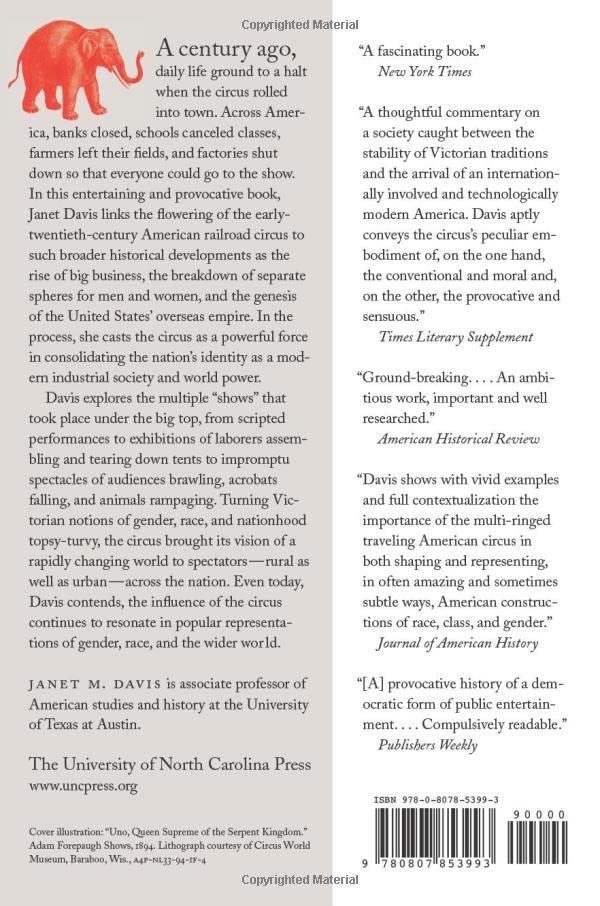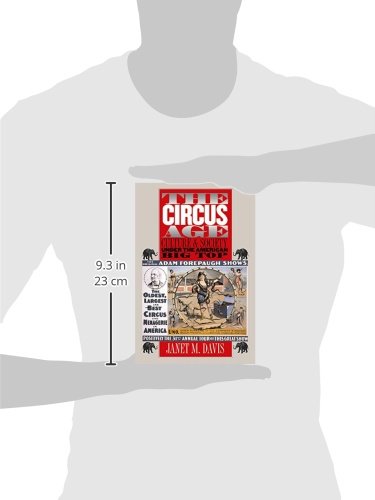



Full description not available
W**D
Well-researched and highly informative
Janet Davis' The Circus Age: Culture & Society Under The American Big Top is a very valuable book for anyone wanting to learn about the history of the American circus and the role it played in culture and society during the classic circus age back when the big circuses traversed the country by railroad and performed under canvas. Davis has done a remarkable amount of research, including finding and interviewing people whose tales about the circus give the reader real insight into what circus life was like and what the circus meant to people back when "Circus Day" was often the biggest event of the year. The book is fairly well illustrated with photographs of circus life and with the posters used to promote the various acts and spectacles the circus would bring to town.Among the wealth of information about the circus are the author's accounts of how extremely organized circuses were, particularly in the setting up and tearing down of the circus 'city' when it came and left town, a necessity born of using the tightly scheduled trains to travel the country. The following is a good example of the useful details Davis brings out in her book:"The 'army' of canvasmen who erected and tore down the billowing canvas tents was a crucial part of the total labor show. Audience members traveled in horse-drawn wagons over miles of bumpy dirt road in predawn darkness just to observe how circus workers (aided by horses and elephants) created a magical, moveable city on an empty lot. At the turn of the century... human and animal labor still performed virtually all the on-site jobs, before gasoline-engine stake-drivers and other motorized machines began replacing some of the human labor in 1910-1920. The creation of the tented city was a thrilling physical feat in which human labor functioned as a seemingly seamless, corporate body."--"Immediately after the circus trains arrived at the show grounds, the boss canvasman, who directed the erection of the tents, scouted out the lot, which occupied ten acres or so. He first decided where the big top should stand, which determined the position of the other eleven tents. A group of canvasmen used iron rods to mark the positions of the five center poles, which would be the tent's center of gravity, and then mapped the perimeter of Barnum & Bailey's 1894 big top - 440 feet by 180 feet - with more rods, topped with little flags, color-coded red or blue to identify each tent site. Next, the boss canvasman and his crew marked the placement of the menagerie tent, which was connected to the big top by a neck of canvas. The perimeter of the menagerie - 360 feet by 160 feet - was identified by rods topped by white flags. This process was completed in just eight minutes from start to finish. The crew then quickly mapped out the placement of the dressing-room tent, two horse tents, the wardrobe tents, the sideshow tent, the freaks' dressing-room tent, and several smaller tents for the blacksmith shop, the repair shop, and so on. The canvasmen finished this whole job in half an hour."--"Next, the boss canvasman directed the unloading of the stake and chain wagons, the pole wagons, the canvas wagons, and other baggage wagons, each drawn by four or six horses. He divided the eighty-five muscular men who composed the 'big top gang' into two groups, of which one laid the stakes into the ground and the other handled the sledges. Each stake was four to five feet long and two or three inches thick, and three-fourths of its length had to be hammered into the ground. Using sledges with three-foot handles and heads that weighed seventeen pounds, groups of about seven men stood in a circle and took turns hammering each stake into the ground, singing rhythmically as they worked. Each group had a leader who initially tapped the stake into position. Meanwhile, groups of pole riggers placed the tents center poles into position. Within forty-five minutes a whistle signaled that the stake drivers and pole riggers had finished, and summoned additional groups of workingmen to help raise the poles. The center poles (as well as the linchpin 'king' pole) were raised with heavy ropes attached to the stakes. In the middle of this process, other workers started joining sections of canvas that would form the tent's roof and side walls. They lifted the canvas using horses, pulley blocks, and a complex array of small side poles. By this time three huge cook wagons had arrived at the site of their tent, and butchers began chopping 500 pounds of meat into individual cutlets, while cooks prepared coffee and eggs. The workingmen raised all twelve tents by six o'clock in the morning -- just two and a half hours after they had typically arrived. At that moment, a loud bell or whistle alerted every circus worker that the dining tent was now open. Now all wagons were stationed at their proper places. The empty field had been transformed into a temporary canvas city."My only quibble is that the book, while very in depth on the classic age of the big railroad circuses and wild-west shows from the late 1800's through the 1950's, gives only brief attention to the earlier age of the smaller overland wagon circus and to the post-railroad circus of the last fifty years. It is understandable given the focus of Davis' book, but it does keep it from being perhaps the ultimate work on the American circus in general. And while most of the book flows quite well, every now and then Davis lapses into grad-student thesis-paper speak which distracts rather than enlightens (it was obvious by the end of the book that "fin de siecle" is absolutely Davis' favorite word).But all in all, this book is both a good read and an extremely valuable one for anyone interested in the era of the classic American circus and its context in American culture and society during that age. Highly recommended.
L**R
A Liberal's Guide to Social History disguised as a study of the Circus
Buy this book and expect a liberal's condemnation of US social history from 1880 to 1930's. But please don't offend us by pretending that this is a true study of the American Circus. According to this author, If it was male, it was repressive. If it was "Euroamerican" male, it was from the pit of hell. If it was female, it was sexually expoloited. If it was African or "of color", it was representative of the racist society of the time. I struggled through a hundred pages of this trash without a single mention of anything circus-related. In fact at one point the author tells us to "skip ahead" if we don't want a sociology lesson. The author was proud of contributions from well-respected circus historians, but I can't believe Baraboo can be proud of this epistle. Read a chapter - get a few circus facts, all of which are twisted into a knot by the author's preconceptions.If you truly love the history and heritage of the circus, ran as far and as fast as you can away from this work.
R**F
Not a popular history of the circus
I was very disappointed when I started reading this book and realized that it's a history of social change in America that incidentally uses the circus to illustrate its points. It is not primarily a history of the circus. The book is based on a scholarly sociology dissertation, and hence, it has long sections that aren't really even circus-related, such as one on orientalism and another on gender issues. The promotional materials and the book's cover are highly misleading in this regard. I stopped reading about half way through.
I**E
Review of "the Circus Age"
I had wished for more illustrations (in color), but as it is, I am glad I have the book. There are probably ca. 5 pictures in color anyhow. You can keep me on rthe list for Circus Illustration.Thank you. Ingrid Mueller
T**L
Just What I was Looking For
After a surprisingly interesting visit to the Ringling Museum in Sarasota I was anxious to know more about this unsung chapter of American History. This book was everything I wanted and more. Full of well researched facts, insightful conclusions and fascinating details, it reads like a dream. If I could give it 6 stars I would! Well done Janet M. Davis.
J**E
Three Stars
Good book
R**H
Excellent!!!! Read
Coming from a family with a circus background I thought this book gave an accurate depiction of how the circus followed the trends of American society and the cast system in the circus family.Ronald Wallenda Bartosch
L**L
Mirror Images of Society
It helped me understand the culture and society of the circus.
Trustpilot
2 weeks ago
2 days ago